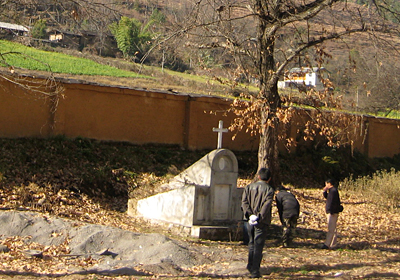Days of Wine and Rosaries
Wine and Catholicism among the Tibetans of China’s Yunnan Province
Tibetans are not known for being Catholics or wine-drinkers, but at least several hundred of them are both, as I learned while working on a dictionary of Trung, an endangered language spoken in the eastern Himalayas. I wasn’t there looking for Tibetans — let alone wine-drinking Tibetan Catholics, whose existence was unknown to me — but one meets all sorts of people, and peoples, in the remote northwest corner of China’s Yunnan Province.
Here, four of Asia’s mightiest rivers slice through towering mountain ranges in close parallel: the Yangtze, the Mekong, the Salween, and the easternmost source of the Irrawaddy, where the Trung live. Linguists call it a borderland between the Sinosphere and the Indosphere, and ecologists see a transition zone between upland Southeast Asia, steep and lush, and the dry moonscape of the Tibetan Plateau. Han Chinese, still few and far between, disparage the region as an untamed, impoverished frontier, while Tibetans speak of it as part of their historical territory, Kham, which extends further than today’s official Tibetan Autonomous Region.
Before I met the region’s Tibetans, I was hearing tales about them. Numerous and organized, they practiced pastoralism while poorer neighbors like the Trung, in a different ecological niche, subsisted on swidden and hunting. Backed by power and wealth, the Tibetans’ Buddhism exerted a powerful influence, though it never fully replaced the indigenous patterns of animism and shamanism. The legends and oral histories I recorded among the Trung invariably dwelled on Tibetan oppression, on the slavers of Chawalong who held the Trung in a kind of debt peonage for immemorial centuries. “We had to pay them taxes, in Chinese goldthread [a medicinal herb] and animal skins,” one Trung storyteller told me. “We went to Chawalong to their chieftains and paid the tribute, and had to buy their salt with the little money we had left.”
Such was Tibetan “feudalism,” to use the (Chinese Communist) Party term: warlike and theocratic well into the mid-twentieth century, until “Liberation” came from Beijing. Opposed to this is the equally simplistic Western line, stoked for a century by opportunists and gurus and Cold Warriors: Tibet as the mystical, snowbound Shangri-la, where beatific lamas guard secret wisdom (sometimes broadcast via Twitter by the much-followed @DalaiLama). Always obscured is the full breadth of Tibetan civilization in all its blood and salt, its twenty-five languages spoken across five countries, the intensity of its regionalism and religious variation.
When I showed up in the village of Dimaluo, one valley over from the Trung, I was hoping to find a guide for the nearby mountains and a place to spend the night. I met Aluo, a young Tibetan who offered just those things. Then he took me to see the two village landmarks: a dusty, much-loved basketball court and an unusual wooden church with delicately painted panels, Tibetan and Chinese characters above the lintel. Recent evangelism I could recognize, but here was evidence of a well-worn faith, easy and open by Chinese standards, though isolated by sheer distance and by the world’s most intractable political feud: the Holy See versus the People’s Republic.
In the homes of Dimaluo I saw old prints of Jesus and the Virgin, not prayer flags; I saw Catholic calendars with the saints’ days marked, brought by visitors all the way from Hong Kong. And then there was the wine — how could there be drinkable red wine (albeit a little sweet) so deep in the Chinese outback, at a time when it was still hard to find a decent glass in Beijing?
The story, as I came to understand it, went something like this: the Society of Foreign Missions of Paris (still going strong today after 350 years) was planning to evangelize Tibet. It was the mid-nineteenth century, and French adventurers had slowly been nudging the empire’s influence up the Mekong from its Asian base in Indochina. The Pope granted his assent; the Qing, under duress, added theirs. Barred, sometimes violently, from preaching within Tibet itself, the missionaries set up camp among the Tibetans living right on its edge, in northwest Yunnan.
What inroads they made proved to be intensely local — family by family, village by village — and Tibetan Catholicism never extended beyond a few valleys, a few thousand souls. The Trung — many of whom are now converting to a kind of indigenous evangelical Protestantism—were never “reached,” but some of their Nu cousins were. After eighty years of this unimaginably difficult and controversial work, the missionaries were sent packing by the party after 1949.
The most revered and best-remembered of the fathers, Père Genestier, lies buried in a Bingzhongluo churchyard, which I visited one Christmas as the bells were ringing and the Tibetan dancers were starting to form their circles. Let Party atheists, orthodox Catholics, and other Tibetans think what they may: by now the Tibetan Catholics emphatically have their own thing going.
As for the wine, it’s a Cabernet Sauvignon varietal, a rose honey strain, which the missionary fathers first brought as seedlings from France, along with cultivation and wine-making techniques still maintained to this day. The grape was lost in France, decimated by a blight, but survives in Yunnan. Now the local government, seeing cash crop potential, is promoting its spread across the region, well beyond the fathers’ original reach. And I read that last year “the French” returned to the area: Moët Hennessy, the luxury wine and spirits maker, is starting a new joint venture with a Chinese company, Shangri-La Winery.









































































































